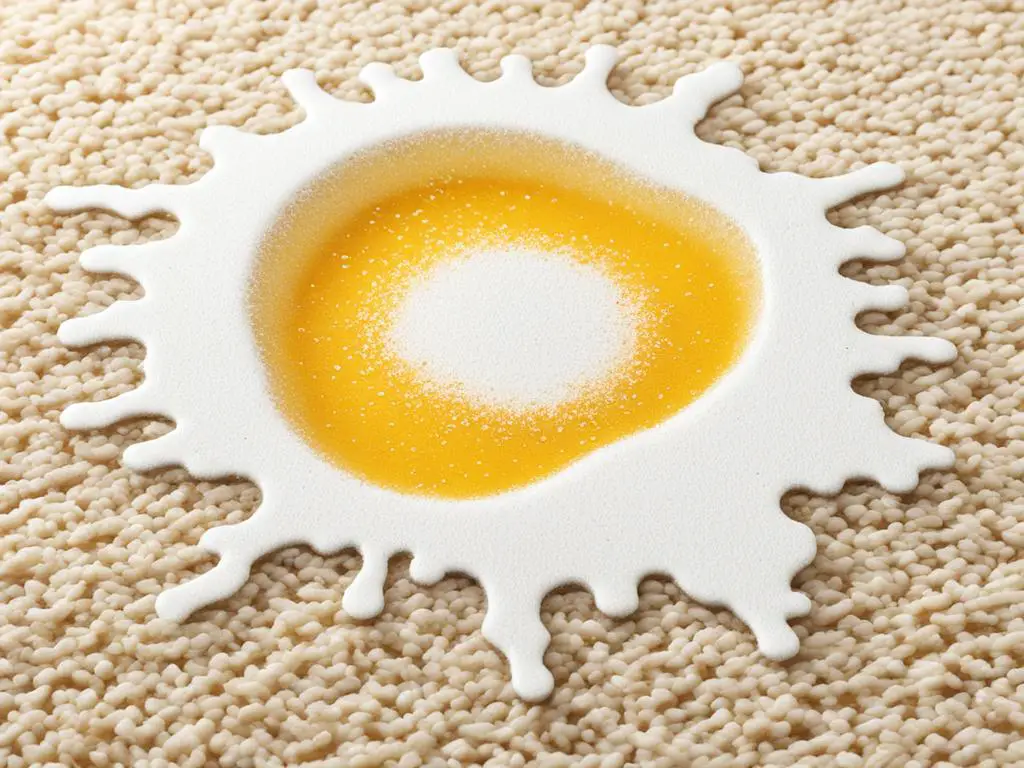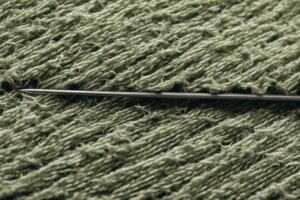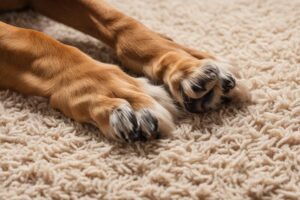Have you ever wondered why your carpet feels sticky even after cleaning it? A sticky carpet can be frustrating, but understanding the causes can help you find effective solutions. Let’s uncover the mystery behind sticky carpets and explore ways to keep your carpets clean and residue-free.
Key Takeaways:
- Rental carpet cleaning machines can leave behind a sticky residue if proper cleaning techniques are not followed.
- Common causes of sticky carpets include leftover cleaning solutions, dirt, oils, shoe scuffs, furniture stains, pet stains, and even mold or mildew growth.
- Removing sticky residue from carpets can be done by vacuuming, using a mixture of water and vinegar, or using a carpet cleaner machine with hot water and vinegar.
- Prevention techniques for sticky carpets include using the right cleaning products, avoiding excessive use of cleaning solutions, thorough rinsing, regular vacuuming, and professional carpet cleaning services.
- To deal with black marks on carpets, gentle cleaning techniques such as blotting with warm water, using mild liquid dish soap, or using isopropyl alcohol can be effective.
- Wicking, the resurfacing of stains due to improper cleaning methods, can be prevented by ensuring proper extraction and drying techniques.
- Consulting a professional carpet cleaning service can offer expert advice and ensure a thorough and residue-free cleaning process.
Common Causes of Sticky Carpets
Sticky carpets can be a frustrating problem to deal with. There are several common causes that can contribute to the stickiness of your carpet. By identifying the specific cause, you can determine the most effective cleaning method to restore your carpet’s cleanliness and freshness.
One common cause of sticky carpets is the remnants of cleaning solutions. If you have recently cleaned your carpet using a rental carpet cleaning machine or a DIY solution, there may be residue left behind. This residue can make your carpet feel sticky and unpleasant to walk on.
Another factor that can contribute to sticky carpets is dirt and oils that have been left behind in the carpet fibers. Over time, these substances can accumulate and create a sticky residue. This residue can attract more dirt and make your carpet look dirty and unkempt.
Additionally, shoe scuffs, furniture stains, and pet stains can also contribute to the stickiness of your carpet. The friction and pressure from shoes, furniture, and pet activity can leave behind marks and residue that create a sticky surface.
In some cases, mold or mildew growth can be the cause of sticky carpets. Moisture and improper ventilation can create a favorable environment for mold and mildew to grow, leading to sticky, unpleasant carpets.
To give your carpet the fresh and clean feel it deserves, it is essential to identify the specific cause of the stickiness. This will allow you to choose the appropriate cleaning method and effectively remove the sticky residue.
Here are some common causes of sticky carpets:
- Remnants of cleaning solutions
- Dirt and oils left behind in the carpet fibers
- Shoe scuffs, furniture stains, and pet stains
- Mold or mildew growth
Next, we will discuss effective methods to remove sticky residue from your carpets and prevent it from recurring.
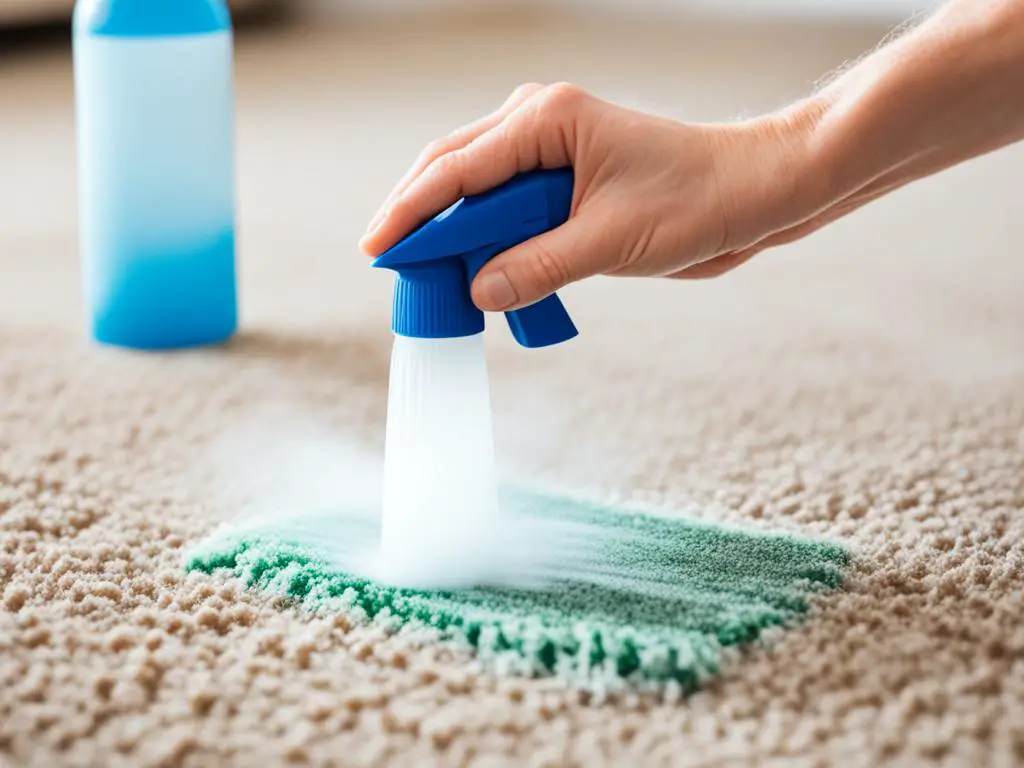
Removing Sticky Residue from Carpets
When faced with a sticky carpet, it’s essential to know how to effectively remove the residue. Luckily, there are several methods you can try to restore your carpet’s cleanliness and softness.
- Vacuuming: Start by vacuuming the affected area. This can help break apart and remove encapsulation-type cleaning solutions that may be causing the stickiness.
- Vinegar-Water Mixture: Mix equal parts of water and vinegar in a bowl. Soak a clean cloth in the mixture and wring out any excess liquid. Gently rub the cloth over the sticky area, applying slight pressure to break down the residue. Vinegar’s acidic properties help dissolve sticky substances effectively.
- Carpet Cleaner Machine: For more stubborn residue, using a carpet cleaner machine with hot water and vinegar can provide a deeper clean. Follow the instructions provided by the manufacturer for optimal results.
It’s important to note that before attempting any cleaning method, always test it on an inconspicuous area of the carpet to ensure it doesn’t cause any damage or discoloration.
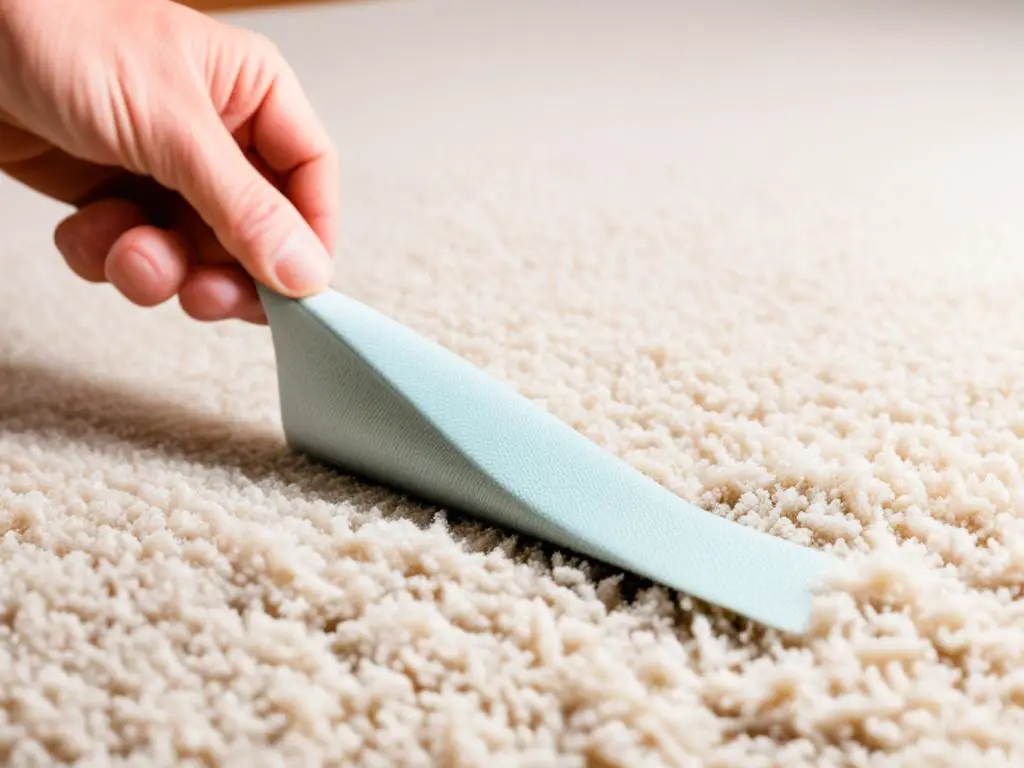
Pro Tip: When using any cleaning solution or machine on your carpet, it’s crucial to thoroughly rinse and dry the area afterward to prevent any leftover residue from attracting dirt and causing the carpet to become sticky again.
Prevention Techniques for Sticky Carpets
To prevent sticky carpets, it is essential to use the right cleaning products and techniques. By following these preventive measures, you can maintain a clean and residue-free carpet.
Choose the Right Cleaning Products
When cleaning your carpets, avoid using excessive amounts of cleaning solutions. This can lead to sticky residues that are difficult to remove. Instead, follow the recommended dosage instructions provided by the cleaning product manufacturer. Using a cleaning agent that is easy to remove and doesn’t leave behind any sticky or detergent-based residues can help prevent sticky carpets.
Thoroughly Rinse the Carpet
After using a cleaning solution on your carpet, make sure to thoroughly rinse the area. This will help remove any residual residue that may be left behind. Use clean water and a damp cloth or sponge to rinse the carpet fibers. Allow the carpet to air dry completely before walking on it to prevent attracting dirt and debris.
Regular Vacuuming
Regular vacuuming is essential for maintaining a clean and residue-free carpet. Vacuuming removes dirt, debris, and loose particles from the carpet fibers, preventing them from becoming sticky and attracting more dirt. Make sure to vacuum all areas of the carpet, including under furniture and in hard-to-reach corners, for comprehensive cleaning.
Professional Carpet Cleaning Services
In addition to regular vacuuming, scheduling professional carpet cleaning services can help keep your carpets clean and free from sticky residues. Professional cleaners have the expertise and specialized equipment to deep clean carpets, removing embedded dirt and preventing sticky buildup. Consider investing in a professional cleaning service at least once or twice a year to maintain the longevity and appearance of your carpets.
By implementing these preventive techniques, you can say goodbye to sticky carpets and enjoy a clean and fresh living space. Remember to always choose the right cleaning products, thoroughly rinse your carpets, regularly vacuum, and seek professional carpet cleaning services for a thorough and residue-free carpet cleaning experience.
Dealing with Black Marks on Carpets
Black marks on carpets can be a common nuisance that can tarnish the overall appearance of your home. These marks can result from various factors, including shoe scuffs, furniture stains, pet stains, and even mold or mildew growth. If left unaddressed, they can become more stubborn and difficult to remove.
To effectively clean black marks on your carpet, it’s important to adopt gentle cleaning techniques that won’t damage the fibers. Here are some methods you can try:
- Blotting with warm water: Start by blotting the affected area with a clean cloth or sponge soaked in warm water. Gently rub the mark in a circular motion to loosen the dirt or stains. Avoid scrubbing vigorously, as this may push the stains deeper into the carpet.
- Using mild liquid dish soap: If warm water alone doesn’t suffice, mix a small amount of mild liquid dish soap with warm water. Apply the soapy solution to the black marks using a clean cloth or sponge. Blot the area gently and rinse with water to remove any soap residue.
- Using isopropyl alcohol: Isopropyl alcohol can be an effective solution for removing black marks from carpets. Dampen a clean cloth with isopropyl alcohol and gently dab it onto the marks. Allow the alcohol to sit for a few minutes and then blot the area with a clean cloth or sponge soaked in warm water. Rinse thoroughly to remove any remnants of alcohol.
Remember, it’s important to address the underlying cause of the black marks to prevent them from reoccurring. If the marks result from shoe scuffs, consider placing doormats near entrances or enforcing a no-shoes policy indoors. For furniture stains, use furniture pads or protectors to prevent future damage. If the black marks are due to pet stains, address any pet training or behavioral issues and consider professional pet stain removal services.
By addressing black marks promptly and employing the right cleaning techniques, you can restore the beauty of your carpet and maintain a clean and inviting home environment.
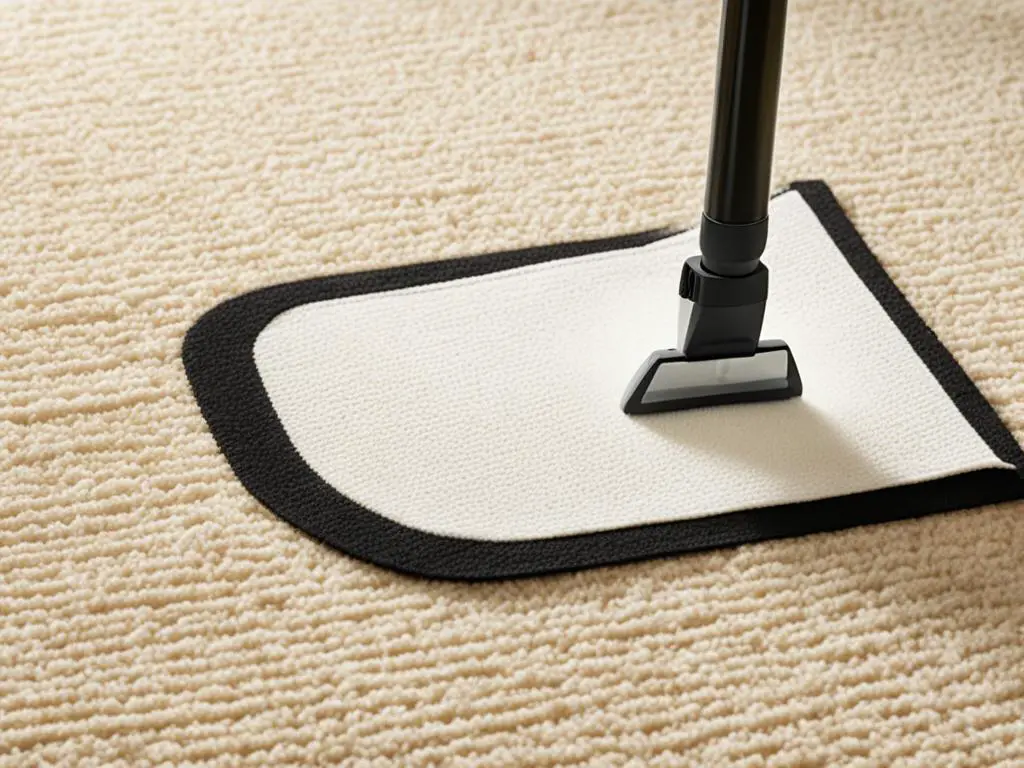
Expert Tip:
“For stubborn black marks, you can also try using a carpet stain remover specifically designed for tough stains. Always test the product on a small, inconspicuous area of the carpet first to ensure it doesn’t cause any discoloration or damage.”
Wicking and its Impact on Carpet Stains
Wicking is a common issue that can contribute to carpet stains and the persistent feeling of stickiness. It occurs when liquid staining agents penetrate the bottom of carpet fibers and travel upwards through capillary action. This upward movement can lead to the reoccurrence of stains even after cleaning, as the liquid continues to rise to the surface.
The primary cause of wicking is improper cleaning methods that leave behind excess moisture and detergent in the carpet. When carpets are not thoroughly extracted and dried, the staining agents are not completely removed, allowing them to migrate back up to the surface over time.
To effectively address wicking and ensure a thorough cleaning, proper extraction and drying techniques are essential. By removing excess moisture and residue, you can prevent the staining agents from traveling upwards and create a clean and dry carpet surface.
In cases of severe wicking or persistent stains, it may be necessary to seek professional carpet cleaning services. These experts have the knowledge and equipment to perform deep extraction and drying, effectively eliminating wicking and leaving your carpet clean and free from stickiness.
Conclusion
Understanding the reasons behind sticky carpets and black marks is crucial when it comes to finding effective solutions and prevention techniques. By selecting the right cleaning products and ensuring complete residue removal, you can keep your carpets clean and free from stickiness. Additionally, addressing underlying issues like mold or wicking is essential for long-term carpet maintenance.
When faced with stubborn residue or persistent carpet issues, it’s wise to seek the advice of a professional carpet cleaning company. Their expertise and knowledge can provide you with the best methods to remove sticky residue from your carpet and address any other carpet-related concerns you may have. Professional carpet cleaners have the necessary equipment and experience to ensure a thorough and residue-free cleaning process, leaving your carpets fresh, clean, and revitalized.
Remember, prevention is key. To maintain a clean and sticky-free carpet, use the correct amount of cleaning solutions and rinse your carpets thoroughly. Regular vacuuming and periodic professional carpet cleaning services can help keep your carpets in top condition. By following these tips and seeking professional guidance when needed, you can enjoy clean, fresh carpets that are free from sticky residue and other unwanted marks.
